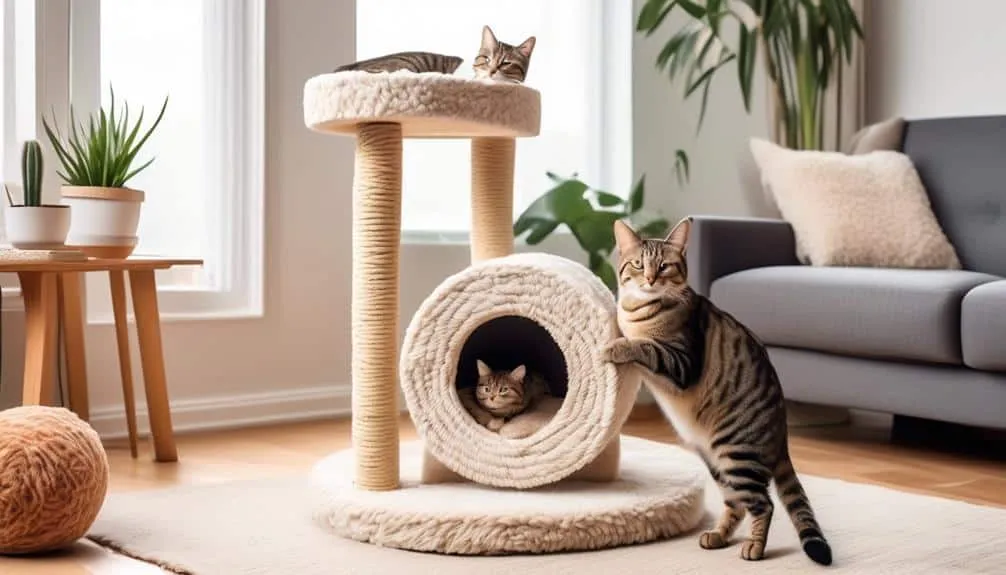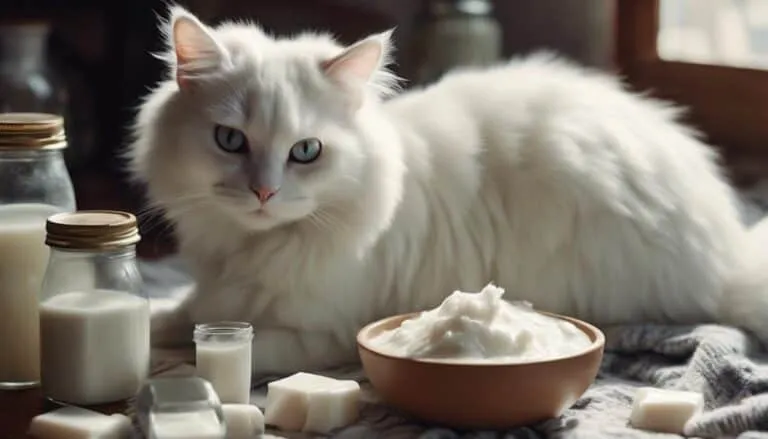The Best Fluffy Pancakes recipe you will fall in love with. Full of tips and tricks to help you make the best pancakes.

Are you tired of your furniture being scratched to shreds, but hesitant to declaw your beloved feline? Well, fear not, because there are effective alternatives that can save your couch and keep your cat content.
In this discussion, we will uncover the reasons behind cats' scratching behavior and why declawing is not the answer. Stick around to discover the importance of providing appropriate scratching areas, how to make them more enticing than your furniture, and explore the option of nail care and nail caps.
Your cat's well-being and your furniture's salvation are just a few paragraphs away.
Key Takeaways
- Declawing cats is not the only solution to protect furniture and ensure safety.
- Understanding why cats scratch is crucial in finding alternatives to declawing.
- Providing appropriate scratching areas and using deterrents can redirect scratching behavior.
- Positive reinforcement training, regular nail care, and nail caps are effective alternatives to declawing.
Reasons for Avoiding Declawing
Avoiding declawing is a crucial decision for cat owners due to the potential negative physical and psychological effects it can have on felines. Declawing consequences include pain, infection, and the loss of normal behavior for cats. Ethical concerns also arise as declawing is considered an unnecessary and invasive procedure.
It's important to consider alternative options that can effectively address the issues associated with scratching. Providing appropriate scratching areas, using deterrents, and making these areas more appealing are all effective strategies. Positive reinforcement training and regular nail care are also important aspects to consider.
Nail caps can be a viable alternative to declawing, offering protection without compromising the cat's natural instincts. By choosing alternatives to declawing, cat owners can ensure the well-being and happiness of their feline companions.
Understanding Cat Scratching Behavior
Understanding why cats scratch is essential for cat owners to effectively address their scratching behavior. Here are the key reasons why cats engage in destructive scratching:
- Territory marking: Scratching allows cats to leave visual and scent marks, establishing their territory and communicating with other cats.
- Stretching and relieving boredom: Cats scratch to stretch their muscles and alleviate boredom, helping to keep them physically and mentally stimulated.
- Instinctual behavior: Scratching is a natural instinct for cats, rooted in their need to maintain healthy claws and exercise their paws.
It is important to understand these reasons because declawing, which involves the removal of a cat's claws, can have serious consequences. Declawed cats may experience pain, balance issues, behavioral changes, and difficulty defending themselves.
Providing Appropriate Scratching Areas
To provide appropriate scratching areas for your cat, ensure that you have strategically placed scratching posts in socially significant areas of your home. Scratching is a natural behavior for cats, and it serves several important purposes.
By providing scratching posts, you give your cat a designated area to scratch and help protect your furniture. The importance of scratching posts can't be overstated. They allow cats to mark their territory, stretch their muscles, and relieve boredom.
When placing scratching posts, consider the areas where your cat spends the most time, such as near their favorite resting spots or by windows. It's also crucial to provide a variety of scratching materials, such as sisal, carpet, or cardboard, to cater to your cat's preferences.
Using Deterrents for Furniture Protection
When it comes to protecting your furniture from your cat's scratching instincts, there are effective alternatives that can help deter them without resorting to declawing. Here are three ways you can use deterrents to make your furniture less appealing to your cat:
- Avoid using essential oils as deterrents: While some essential oils may have a strong scent that cats dislike, many essential oils can be toxic to them. It's best to err on the side of caution and look for safer alternatives.
- Use furniture covers to protect surfaces: By covering your furniture with protective covers, you can create a barrier between your cat's claws and the fabric. This can help prevent damage while still allowing your cat to explore and climb.
- Foils, sticky tape, and spike mats can deter scratching: Cats generally dislike the texture and sensation of foils, sticky tape, and spike mats on their paws. Placing these deterrents on or near your furniture can discourage scratching and redirect their behavior to more appropriate areas.
Making Scratching Posts More Appealing
To make scratching posts more appealing to your cat, provide different textures and materials for them to scratch on. Cats are attracted to a variety of surfaces, so offering a range of options will increase their interest in using the scratching post.
Consider providing posts covered in sisal, carpet, or corrugated cardboard, as these materials are known to be appealing to cats. Additionally, you can try sprinkling some catnip on the scratching post to attract your cat to it.
Regularly replacing worn-out scratching posts is also important, as cats may lose interest if the post becomes too worn or damaged. By providing a variety of textures, materials, and maintaining the condition of the scratching posts, you can encourage your cat to use them instead of your furniture.
Positive Reinforcement Training for Cats
Can positive reinforcement training be an effective way to redirect cats' scratching behavior? Absolutely! Training techniques that utilize rewards-based training have shown great success in redirecting cats to use appropriate scratching areas. Here are three key reasons why positive reinforcement training is a valuable tool in addressing scratching behavior:
- Encourages desired behavior: By rewarding cats when they use appropriate scratching areas, such as scratching posts, you reinforce the behavior you want to see more of. This helps them understand what's expected of them and motivates them to continue using the designated areas.
- Builds a positive association: Using treats or praise as rewards helps create a positive association with using scratching posts. Cats are more likely to repeat behaviors that are associated with positive experiences, making them more inclined to use the appropriate scratching areas.
- Focuses on consistency: Consistency is key in positive reinforcement training. By consistently rewarding desired behavior and redirecting cats to appropriate scratching areas, you establish a clear understanding of what's acceptable. This helps cats develop a habit of using scratching posts instead of furniture.
Positive reinforcement training isn't only effective but also a compassionate approach to redirecting cats' scratching behavior. By using rewards-based training techniques, you can help your cat understand where they should scratch and promote a harmonious relationship between you and your feline friend.
Nail Care and Nail Caps as Alternatives
Nail care and nail caps are effective alternatives to declawing that prioritize the well-being and comfort of your cat. Regular cat grooming and nail care are essential for maintaining your cat's health. Trimming your cat's nails on a regular basis can help prevent them from becoming too sharp and causing damage to furniture or other surfaces. Use cat-friendly nail clippers or grinders to safely trim your cat's nails, and gradually introduce nail trimming to your cat to make the process more comfortable for them. Reward your cat with treats or praise after successful nail trims to reinforce positive behavior.
Additionally, nail caps can be applied to your cat's nails as an alternative to declawing. These soft caps prevent damage from scratching and need to be replaced every few weeks. It's important to have nail caps applied by a professional or with guidance to ensure proper placement and avoid any discomfort for your cat.
Frequently Asked Questions
Are There Any Long-Term Negative Effects of Declawing on a Cat's Behavior?
Declawing can have long-term negative effects on a cat's behavior, such as aggression and litter box issues. However, effective alternatives exist, like providing appropriate scratching areas, using deterrents, positive reinforcement training, nail care, and nail caps.
Can Scratching Posts Be Effective for Older Cats Who Have Already Developed a Habit of Scratching Furniture?
Scratching posts can be effective for older cats who have developed a habit of scratching furniture. Alternatives to scratching posts, such as positive reinforcement training, can help redirect their behavior and provide them with appropriate areas to scratch.
How Do I Choose the Right Scratching Post for My Cat?
To choose the right scratching post for your cat, consider their preferences and needs. Different materials, like sisal or cardboard, offer various benefits. Observe your cat's scratching habits to determine the best option.
Are There Any Risks or Side Effects Associated With Using Motion Activated Sprays as Deterrents?
Using motion activated sprays as deterrents for scratching may have some risks, such as potential allergies or sensitivities. However, when used correctly, they can be effective in redirecting your cat's behavior and protecting your furniture.
What Should I Do if My Cat Refuses to Use the Scratching Post Despite My Efforts to Make It More Appealing?
If your cat refuses to use the scratching post despite your efforts, try different types of scratching surfaces, like horizontal or vertical posts. Use positive reinforcement training to reward your cat when they use the appropriate scratching areas.
Conclusion
In conclusion, declawing isn't the only solution to protect your furniture from your cat's natural scratching behavior. By understanding the reasons behind scratching and providing appropriate alternatives, such as scratching posts and nail care, you can ensure your furry friend remains happy and healthy.
Remember, with positive reinforcement training and a little effort, you can have a harmonious home without resorting to drastic measures. So, say no to declawing and yes to effective alternatives that keep both you and your feline companion content.








